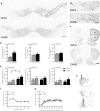Chondroitinase ABC reduces dopaminergic nigral cell death and striatal terminal loss in a 6-hydroxydopamine partial lesion mouse model of Parkinson's disease
- PMID: 31862005
- PMCID: PMC6923832
- DOI: 10.1186/s12868-019-0543-3
Chondroitinase ABC reduces dopaminergic nigral cell death and striatal terminal loss in a 6-hydroxydopamine partial lesion mouse model of Parkinson's disease
Abstract
Background: Parkinson's disease (PD) is characterised by dopaminergic cell loss within the substantia nigra pars compacta (SNc) that leads to reduced striatal dopamine content and resulting motor deficits. Identifying new strategies to protect these cells from degeneration and retain striatal dopaminergic innervation is therefore of great importance. Chondroitin sulphate proteoglycans (CSPGs) are recognised contributors to the inhibitory extracellular milieu known to hinder tissue recovery following CNS damage. Digestion of these molecules by the bacterial lyase chondroitinase ABC (ChABC) has been shown to promote functional recovery in animal models of neurological injury. Although ChABC has been shown to promote sprouting of dopaminergic axons following transection of the nigrostriatal pathway, its ability to protect against nigrostriatal degeneration in a toxin-based module with better construct validity for PD has yet to be explored. Here we examined the neuroprotective efficacy of ChABC treatment in the full and partial 6-hydroxydopamine (6-OHDA) lesion mouse models of PD.
Results: In mice bearing a full 6-OHDA lesion, ChABC treatment failed to protect against the loss of either nigral cells or striatal terminals. In contrast, in mice bearing a partial 6-OHDA lesion, ChABC treatment significantly protected cells of the rostral SNc, which remained at more than double the numbers seen in vehicle-treated animals. In the partial lesion model, ChABC treatment also significantly preserved dopaminergic fibres of the rostral dorsal striatum which increased from 15.3 ± 3.5% of the intact hemisphere in saline-treated animals to 36.3 ± 6.5% in the ChABC-treated group. These protective effects of ChABC treatment were not accompanied by improvements in either the cylinder or amphetamine-induced rotations tests of motor function.
Conclusions: ChABC treatment provided significant protection against a partial 6-OHDA lesion of the nigrostriatal tract although the degree of protection was not sufficient to improve motor outcomes. These results support further investigations into the benefits of ChABC treatment for providing neuroprotection in PD.
Keywords: 6-Hydroxydopamine; Chondroitin sulphate proteoglycans; Chondroitinase ABC; Neuroprotection; Parkinson’s disease.
Conflict of interest statement
The authors declare that they have no competing interests.
Figures


Similar articles
-
Characterization of liraglutide, a glucagon-like peptide-1 (GLP-1) receptor agonist, in rat partial and full nigral 6-hydroxydopamine lesion models of Parkinson's disease.Brain Res. 2016 Sep 1;1646:354-365. doi: 10.1016/j.brainres.2016.05.038. Epub 2016 May 24. Brain Res. 2016. PMID: 27233809
-
The Kv7/KCNQ channel blocker XE991 protects nigral dopaminergic neurons in the 6-hydroxydopamine rat model of Parkinson's disease.Brain Res Bull. 2018 Mar;137:132-139. doi: 10.1016/j.brainresbull.2017.11.011. Epub 2017 Nov 22. Brain Res Bull. 2018. PMID: 29174294
-
Small molecule TrkB agonist deoxygedunin protects nigrostriatal dopaminergic neurons from 6-OHDA and MPTP induced neurotoxicity in rodents.Neuropharmacology. 2015 Dec;99:448-58. doi: 10.1016/j.neuropharm.2015.08.016. Epub 2015 Aug 14. Neuropharmacology. 2015. PMID: 26282118
-
Neonatal 6-hydroxydopamine lesioning of rats and dopaminergic neurotoxicity: proposed animal model of Parkinson's disease.J Neural Transm (Vienna). 2022 Jun;129(5-6):445-461. doi: 10.1007/s00702-022-02479-4. Epub 2022 Mar 12. J Neural Transm (Vienna). 2022. PMID: 35279767 Review.
-
Involvement of the Protein Ras Homolog Enriched in the Striatum, Rhes, in Dopaminergic Neurons' Degeneration: Link to Parkinson's Disease.Int J Mol Sci. 2021 May 18;22(10):5326. doi: 10.3390/ijms22105326. Int J Mol Sci. 2021. PMID: 34070217 Free PMC article. Review.
Cited by
-
Inhibition of PTPRS function does not affect the survival or regeneration of dopaminergic neurons but alters synaptic function in the nigrostriatal pathway.Neurobiol Dis. 2025 Sep;213:107023. doi: 10.1016/j.nbd.2025.107023. Epub 2025 Jul 5. Neurobiol Dis. 2025. PMID: 40623478
-
A Single Domain Shark Antibody Targeting the Transferrin Receptor 1 Delivers a TrkB Agonist Antibody to the Brain and Provides Full Neuroprotection in a Mouse Model of Parkinson's Disease.Pharmaceutics. 2022 Jun 24;14(7):1335. doi: 10.3390/pharmaceutics14071335. Pharmaceutics. 2022. PMID: 35890231 Free PMC article.
-
Neuronal plasticity and its role in Alzheimer's disease and Parkinson's disease.Neural Regen Res. 2026 Jan 1;21(1):107-125. doi: 10.4103/NRR.NRR-D-24-01019. Epub 2024 Dec 16. Neural Regen Res. 2026. PMID: 39688547 Free PMC article.
References
-
- Kwok JC, Afshari F, Garcia-Alias G, Fawcett JW. Proteoglycans in the central nervous system: plasticity, regeneration and their stimulation with chondroitinase ABC. Restor Neurol Neurosci. 2008;26(2–3):131–145. - PubMed
Publication types
MeSH terms
Substances
LinkOut - more resources
Full Text Sources
Miscellaneous

